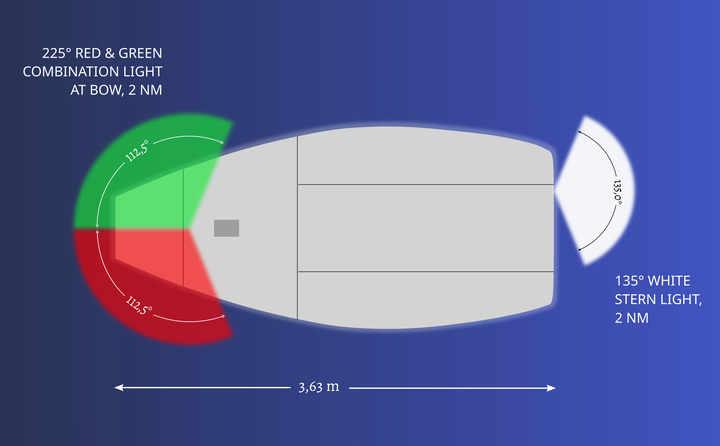SCAMP navigation light options
Deciding navigation light positions is a complicated matter on Scamp. Here are the main options weighed against the need for sailing and rowing. The COLREGS refers to the Code of Conduct for the Maritime Regions, which is in effect world-wide, including Finland. In addition, the CEVNI regulations are in force in some parts of Europe and in Russia. In the Nordic countries, the CEVNI Code is not applicable, but in the case of navigation lights in Finland, CEVNI-compliant lights are an alternative to COLREGS-compliant lights.
Powerful torch. For a boat shorter than seven meters COLREGS sets a minimum requirement of having a torch (flashlight) to prevent collisions (rule 25(d)(i)). However, noticing approaching traffic requires the crew to be alert. It can be challenging to sail single-handed when using a torch. In CEVNI waters this option alone isn’t legal.
360° white light pole in cockpit. The simplest and the most affordable fixed light solution is to install a light pole into the cockpit. That’s not a perfect option because finding a proper position on boat is difficult, as the mainsail sheet travel within a large area at the stern. Ensuring an unobstructed all-round sector isn’t that easy either. Also, a white light isn’t ideal because it doesn’t indicate your direction and in cockpit disturbs your night vision. In CEVNI waters this option isn’t legal either.
225° red/green at bow and 135° white at stern. This is the preferred configuration recommended by COLREGS for small sailboats. It allows you to sail, row and to be towed in COLREGS waters. For motoring and anchoring you should have a portable 360° white light. Offshore visibility of lights on the deck is far from that of mast top lights. Attaching lights to the hull affects to the look of the boat, and because of reflections deck lights can adversely affect your night vision.
360° all-round white light at mast top. Human eye also recognises white light better than green or red when viewed from faraway, making this option a very visible one when offshore, although sailing in dark offshore in a sailing dinghy is something that should be avoided. A light at mast top can be seen far when sailing offshore but in a busy harbour not everybody is able to see it well, especially if the mast top light gets blends in the city lights in the background. The lugsail and yard may obstruct the light but reefing would help that. On the other hand, COLREGS allows obstruction of up to 6° for all-round lights. Obstruction also means that the peak area of the sail and the yard reflect slightly the light. On the other hand, a white light doesn’t tell anything about your direction. COLREGS rules permit this option for sailing vessels less than seven meters long (rule 25(d)(i)), but likely rather as a portable than a fixed light. In CEVNI waters a separate torch is also needed in the cockpot, to warn approaching vessels when needed (rule 3.13(5)).
Tricolor and anchor light at mast top. This option is similar to the previous one, except that visibility is weaker for the reason mentioned above. The rule about 6° obstruction is for all-round lights, while tricolor is a combination of sector lights. If the tricolour is to be used in Scamp according to the letter of the law, the sail must be reefed to remove the obstruction caused by the yard. An advantage of tricolor compared to the all-round white light is that the other boaters can derive your direction. However, compared to deck lights, it is difficult for other boats to perceive the distance of a tricolor boat in the dark. This option has traditionally been the power-saving choice of the battery saver, but with modern LED lights, the low wattage of the tricolor is no longer a significant advantage.
360° green and 360° red light on mast in addition to the deck lights. This combination of 4-5 lights is a very visible and eye-catching option, but also complex and quite expensive to implement. With regard to 360° lights, the small obstructions around the mast created by the log-sail and yard are not a problem from a regulatory point of view. The main challenge with this option is to get the 360° green light far enough away from the mast to keep the mast-created obscuration to less than 6°. Since the 360° lights must be in a vertical line with each other, the red light at the top must also be as far from the mast as the green light. If the diameter of the mast top is 5 cm, the lights should be at least about 50 cm from the mast to meet the 6° requirement. So this would be a rather peculiar and impractical solution for a small craft.
As we want to avoid sailing a dinghy offshore in the dark, the option about deck-installed 225° red/green bow light and 135°C white stern light is the most reasonable one. On the other hand, to achive best visibility to ships at sea a proper radar reflector and especially an AIS transponder are notable gear nowadays. Their range is multiple compared to navigation lights, and they are helpful in the daytime and in fog too.
External articles
- Introduction to vessel running lights, David Burch Navigation Blog, 2020
| Back: | Navigation lights |
